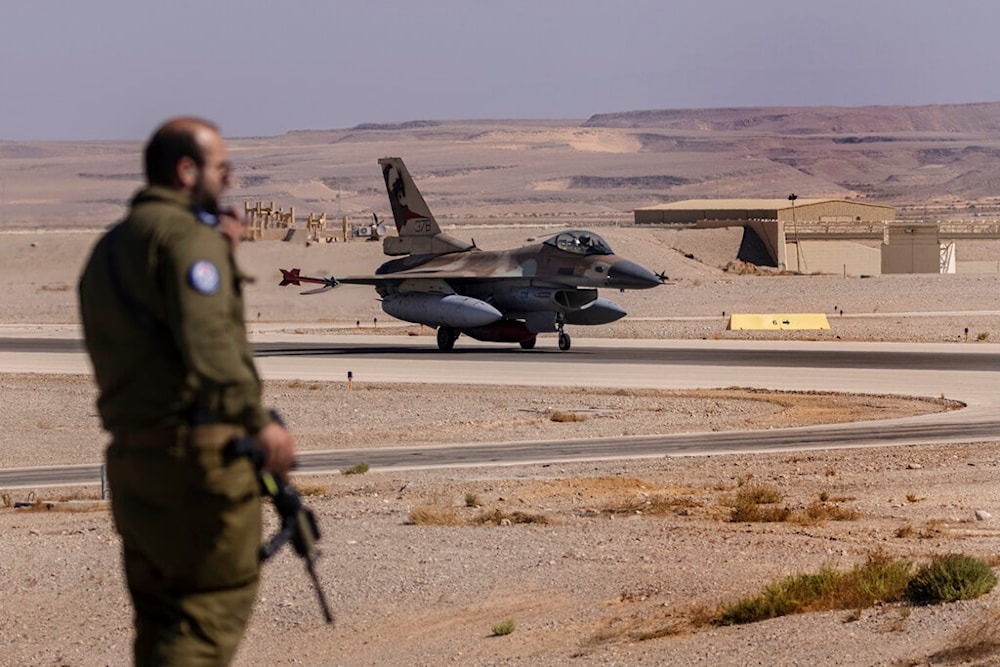War on Gaza would not have lasted without US support: Israeli officer
A senior Israeli officer in the Air Force underlines that the Israeli occupation would not have been able to continue the war on Gaza without the ongoing support from the United States.
-

An Israeli officer watches as an F-16 taxis at Ovda airbase near Eilat, southern occupied Palestine, Sunday, October 24, 2021 (AP)
An Israeli Air Force senior officer has disclosed plans to increase the production of bombs, missiles, and other munitions within the Israeli occupation, aiming to reduce the air force's reliance on foreign suppliers, particularly the United States.
Speaking to the Israeli newspaper Haaretz, the officer emphasized that without American support, the Israeli military, especially the air force, would face significant difficulties in sustaining its aggression for more than a few months.
The recommendation comes amid the Israeli occupation's growing desire to minimize its dependence on external suppliers, according to the newspaper.
This shift is driven by concerns over delays in arms shipments from the Biden administration. These delays have particularly affected the Air Force, as most of its equipment is purchased from American companies and funded through US military aid.
After these delays, the Biden administration, with Congressional approval, sent unprecedented emergency military supplies shipments worth $14 billion, in addition to the regular annual US military aid of $3.8 billion. Washington also provided an additional $500 million for Israeli air defense systems.
Haaretz drew parallels between the current situation and the Israeli occupation's experience during the 1967 war, when French President Charles de Gaulle imposed an arms embargo on "Israel", cutting off supplies of tanks, missile boats, and Mirage aircraft. At that time, the occupation shifted its reliance to the United States, which has since supplied the Israeli Air Force with all its fighter jets, as well as some bombs, missiles, and intelligence equipment.
Air Force investigating October 7 failure
The Israeli Air Force is conducting two comprehensive investigations, the officer said, noting that the first focuses on the events of October 7, during Operation al-Aqsa Flood, while the second examines the condition of the Air Force since October 8.
The officer expects the findings to lead to a fundamental shift in the Air Force's combat doctrine, including border security, force structure, operational readiness, and the protection of key Air Force assets and bases.
The officer acknowledged that Hamas' Resistance managed to reach military bases near Gaza during Operation al-Aqsa Flood. Additionally, Hezbollah inflicted damage on an Israeli air force base on Mount Meron and the Sky Dew aerial surveillance system near the Golani Junction on the northern front.
He further stated that the investigations are "harsh, and there is no desire to hide or cover up" the failures of October 7.
An objective assessment will also be conducted on attacks in Lebanon, Gaza, Syria, and the assault on the port of Hodeidah in Yemen. The officer added that he does not "wish to make excuses" for what occurred during Operation al-Aqsa Flood.
The officer stressed that the Air Force, which was under the Southern Command, was not solely responsible for the "massive failure" faced by the occupation and its military as a whole.
The surprise was "substantial and comprehensive" compared to the reference scenario, with military intelligence and the internal security agency, the Shin Bet, bearing responsibility for failing to provide adequate warnings of a potential operation, even if limited to a few sites.
The officer revealed that there was a plan anticipating an operation involving "dozens of terrorists at two or three sites," with the scenario being codenamed "Palestinian Knight."
October 7 revelations
The officer disclosed that Palestinian Resistance forces targeted two Israeli helicopters carrying a paratrooper unit on October 7. The helicopters were hit by ground fire and an anti-tank missile.
The unit managed to quickly evacuate the severely damaged helicopter, which later burned, with one pilot suffering a leg injury. That pilot is now the commander of an airbase.
On that day, the Israeli Air Force dropped 50,000 bombs, missiles, and shells on Gaza, with two-thirds of the attack consisting of one-ton bombs, according to the officer.
Iranian retaliation against 'Israel'
The officer also revealed that Tehran aimed to inflict significant damage on the Nevatim Air Base in southern occupied Palestine during its Operation True Promise on April 13. The base houses Israeli squadrons of F-35 fighter jets as part of the operation.
Iran also launched several surface-to-surface missiles at Mount Hermon in the far north of occupied Palestine, a move the officer described as a diversion tactic.
The officer revealed that four of the ground-to-ground missiles successfully hit their targets, including a building at Nevatim. He emphasized the critical role played by American, British, and French aircraft in intercepting the Iranian attack.
Additionally, he mentioned that Jordan and Saudi Arabia provided vital assistance through coordinated radar and warning systems in collaboration with the Israeli occupation and the three Western countries.
The officer highlighted the broader Arab and international cooperation with the Israeli occupation as the "most crucial element" in defending it. He detailed that the operation began with the launch of dozens of drones, which took approximately seven hours to reach the occupied Palestinian territories.
These were later joined by cruise missiles traveling at speeds of 500 kmh, along with several hundred ground-to-ground missiles, some of which were Shehab missiles equipped with warheads ranging from 500 to 1,000 kg.

 5 Min Read
5 Min Read








